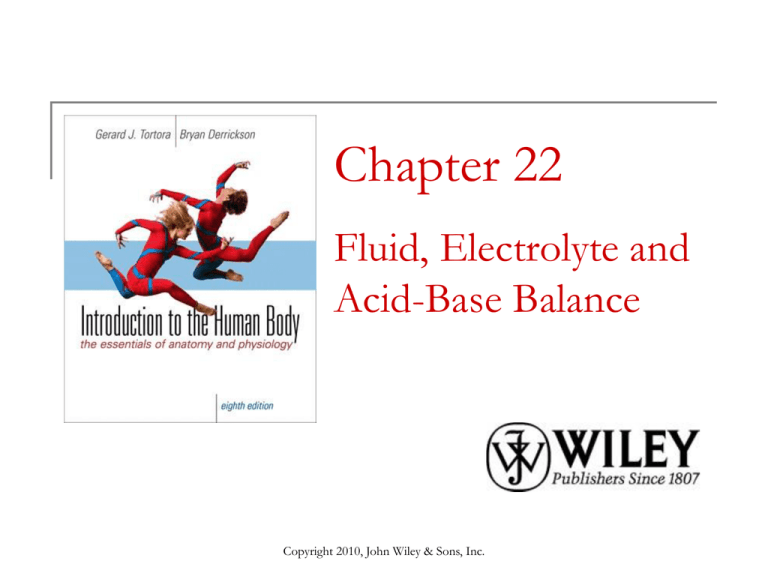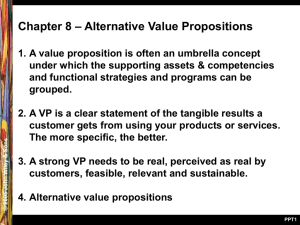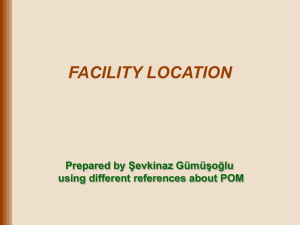
Chapter 22
Fluid, Electrolyte and
Acid-Base Balance
Copyright 2010, John Wiley & Sons, Inc.
End of Chapter 22
Copyright 2010 John Wiley & Sons, Inc.
All rights reserved. Reproduction or translation of
this work beyond that permitted in section 117 of the
1976 United States Copyright Act without express
permission of the copyright owner is unlawful.
Request for further information should be addressed
to the Permission Department, John Wiley & Sons,
Inc. The purchaser may make back-up copies for
his/her own use only and not for distribution or
resale. The Publishers assumes no responsibility
for errors, omissions, or damages caused by the use
of theses programs or from the use of the
information herein.
Copyright 2010, John Wiley & Sons, Inc.
Fluid Compartments
Total body water = 55-60% of lean body
mass
Remainder: solid parts of bone, muscles, tendons
Major compartments (3): ICF, IF, plasma
Intracellular fluid (ICF): inside cells= 2/3
Extracellular Fluid (ECF): outside cells = 1/3
Interstitial fluid (IF): 80% of ECF
Includes: lymph; cerebrospinal, synovial, pericardial,
pleural and peritoneal fluids; fluid in eyes and ears
Blood plasma: 20% ECF
Copyright 2010, John Wiley & Sons, Inc.
Fluid Compartments
Copyright 2010, John Wiley & Sons, Inc.
Barriers Between Compartments
Plasma membrane: between ECF and ICF
Blood vessel walls: between plasma and
interstitial fluid
Fluid balance correct distribution of water &
solutes
Water redistributes rapidly by osmosis
Thus fluid balance depends on solute
(electrolyte) balance
Copyright 2010, John Wiley & Sons, Inc.
Fluid Balance
Fluid balance requires
Fluid balance depends on solute (electrolyte
and nonelectrolyte) balance
Appropriate total volume of body fluid
Appropriate distribution of water and solutes
Fluids and electrolytes are closely linked
Water redistributes rapidly by osmosis
Copyright 2010, John Wiley & Sons, Inc.
Fluid Balance
Interactions Animations
Water and Fluid Flow
You must be connected to the internet to run this animation.
Copyright 2010, John Wiley & Sons, Inc.
Water Gain and Loss
Gain: ingestion + metabolic reactions
Gain should = loss
Ingestion (food and drink): 2300 mL/day
Metabolism: 200 mL/day
Daily intake = daily output. Both 2500 mL/day
Loss: skin, lungs, kidneys, GI tract
Kidneys: ~1500 mL/day
Skin: sweat evaporates ~600 mL/day
Lungs: 300 mL/day; more if fever
GI tract: ~100 mL/day; more if diarrhea
Copyright 2010, John Wiley & Sons, Inc.
Water Balance
Copyright 2010, John Wiley & Sons, Inc.
Regulation of Gain
Thirst center in hypothalamus
~2% dehydration will cause BP
Increase in body osmolality dry mouth thirst
Hormonal responses
High osmolality hypothalamus releases ADH
water retention by kidneys
BP renin released from kidney angiotensin II
aldosterone water retention by kidneys
Sensation of thirst may be decreased,
especially in elderly
Copyright 2010, John Wiley & Sons, Inc.
Regulation of Gain
Copyright 2010, John Wiley & Sons, Inc.
Regulation of Salt and Water Loss
Urinary NaCl loss mainly determines body
fluid volume
Fluid intake varies so loss must vary also
Na+ = main solute in ECF determining osmosis
ANP, angiotensin II and aldosterone regulate
ADH regulates water loss
Copyright 2010, John Wiley & Sons, Inc.
Regulation of Salt
and Water Loss
Copyright 2010, John Wiley & Sons, Inc.
Movement of Fluid
ICF and ECF are normally at the same
osmolality
Water moves freely
interstitial fluid osmolality cell swelling
and vice versa
Most often due to Na+ change
ADH responds rapidly: prevents significant
cell change
Copyright 2010, John Wiley & Sons, Inc.
Electrolytes in Body Fluids
Functions of electrolytes
1.
2.
3.
4.
Confined to compartments; control osmosis
Help maintain acid-base balance
Carry electrical currents
Serve as cofactors for enzymes
Copyright 2010, John Wiley & Sons, Inc.
Electrolyte Distribution
Electrolyte content of ICF and ECF differ
significantly
ICF: K+ major cation; protein, HPO42-: anions
ECF: Na+ major cation; Cl- major anion
Na+/K+ pump maintains the cation difference
The two ECF fluids are similar
Electrolytes in plasma similar to those in IF
One difference: plasma contains more protein
than interstitial fluid (IF)
Colloid osmotic pressure (due largely to plasma
proteins) “holds onto” fluid in capillaries
Copyright 2010, John Wiley & Sons, Inc.
Electrolyte Distribution
Copyright 2010, John Wiley & Sons, Inc.
Other Electrolytes
K+ high in ICF, low in ECF
Regulated by aldosterone
Mg2+ and SO42- high in ICF, low in ECF
Ca2+ high in ECF, low in ICF
Regulated in plasma (PTH, calcitriol, and
calcitonin)
Bones serve as Ca2+ reservoir
Copyright 2010, John Wiley & Sons, Inc.
Acid- Base Balance
Input: diet, products of metabolism
Output
Such as lactic acid, ketones
Lungs: exhale CO2
Kidney: can eliminate H+ or HCO3-
Regulatory mechanisms
1. Buffers: fastest but incomplete
2. Respiratory responses: fast but incomplete
3. Renal responses: slowest but compete
elimination
Copyright 2010, John Wiley & Sons, Inc.
1: Buffer Systems
Protein in cells or plasma
Carboxyl and amino groups of amino acids
Hemoglobin (protein) in red blood cells
Carbonic acid-bicarbonate
Especially important in plasma
CO2 + H2O H2CO3 ↔ HCO3- + H+
Phosphate
H2PO4- H+ + HPO42-
Copyright 2010, John Wiley & Sons, Inc.
2: Exhalation of Carbon Dioxide
H+ + HCO3- ↔ H2CO3 ↔ CO2 + H2O
Decrease of CO2 ↔ decrease of H+
Increase of CO2 ↔ increase of H+
Change of rate and depth of ventilation
rapidly alters plasma pH
Negative feedback loop regulates
Copyright 2010, John Wiley & Sons, Inc.
2: Exhalation of
Carbon Dioxide
Copyright 2010, John Wiley & Sons, Inc.
3. Renal Responses
Kidney Excretion of H+
Slow but only way to actually eliminate acid or
base
Secrete H+ and replace with HCO3-
Copyright 2010, John Wiley & Sons, Inc.
Imbalances
Acidosis: arterial blood pH < 7.35
Alkalosis: arterial blood pH > 7.45
Depresses CNS
Below pH 7.0 can be fatal
Overexcitation of CNS
Muscle spasms, convulsions
Compensation
Respiratory or renal mechanisms
Respiratory very rapid; renal slower
Copyright 2010, John Wiley & Sons, Inc.
Aging
Decrease in control of water and electrolyte
balance can lead to pH problems
Decreases in respiratory and renal
functioning
Decreased capacity to sweat
Copyright 2010, John Wiley & Sons, Inc.










